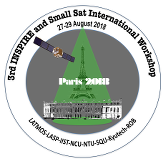Speaker
Dr
Tom Woods
(LASP / University of Colorado)
Description
The Laboratory for Atmospheric and Space Physics (LASP) has developed three solar science CubeSats so far and has three more planned. The first one is called the Miniature X-ray Solar Spectrometer (MinXSS, PI: T. Woods), and it is a NASA Heliophysics 3-Unit (3U) CubeSat to study the energy distribution of solar soft X-ray (SXR) emissions of the quiescent Sun, active regions, and flares, and its data are being used to model the solar SXR impact in Earth’s ionosphere, thermosphere, and mesosphere (ITM). The first of the two MinXSS CubeSats was deployed from the International Space Station (ISS) in May 2016, and the second is expected to be launched in October 2018 along with LASP’s second solar CubeSat called the Compact Spectral Irradiance Monitor (CSIM, PI: E. Richard). The CSIM is a NASA Earth Science 6U CubeSat to study the solar spectral irradiance (SSI) from 200 nm to 2400 nm and is a validation of the CSIM technology with the on-going SIM observations from SORCE and TSIS-1. LASP has three more solar CubeSats planned for the coming years. One is the Compact Total Irradiance Monitor (CTIM, PI: D. Harber), which is a pending NASA Earth Science 6U CubeSat mission to study the total solar irradiance (TSI). The CSIM and CTIM missions are important technology demonstration for the future of the NOAA-NASA climate records of SSI and TSI, respectively. LASP is also planning for the Occultation Wave Limb Sounder (OWLS: PI: E. Thiemann) development in the coming year as a contribution for the INSPIRESat-3 mission. The OWLS is based on a far ultraviolet (FUV) and middle ultraviolet (MUV) solar spectrograph developed for an underflight calibration for SORCE in June 2018; the OWLS is an upgrade of that instrument to make solar occultation measurements to study thermosphere dynamics such as gravity waves. A new solar physics mission is also being planned to study the coronal mass ejections acceleration and energetics low in the corona with a new instrument called the Sun’s Corona Eruption Tracker (SunCET, PI: P. Chamberlin). The SunCET mission is also a technology demonstration effort to mature this new compact instrument that has an imager channel and a spectrograph channel for solar extreme ultraviolet (EUV) observations. The miniaturization of technology over the past few years has enabled the ability to make these compact instruments that are appropriate for science CubeSat missions. Furthermore, space agencies are realizing the great value of low-cost, small missions for some of their science goals, industry partners are providing reliable spacecraft bus systems small enough for CubeSats, and launch service providers are offering many more opportunities for secondary rides into space than ever before.
Summary
The Laboratory for Atmospheric and Space Physics (LASP) has developed three solar science CubeSats so far and has three more planned. MinXSS-1 had successful science mission in 2016-2017. MinXSS-2 and CSIM are launching in October 2018. The three new CubeSat instruments are called CTIM, OWLS, and SunCET. The OWLS is being planned for launch on INSPIRESat-3.
Primary author
Dr
Tom Woods
(LASP / University of Colorado)
Co-authors
Dr
Dave Harber
(LASP / University of Colorado)
Dr
Ed Thiemann
(LASP, University of Colorado)
Dr
Erik Richard
(LASP / University of Colorado)
Dr
Phil Chamberlin
(LASP / University of Colorado)

